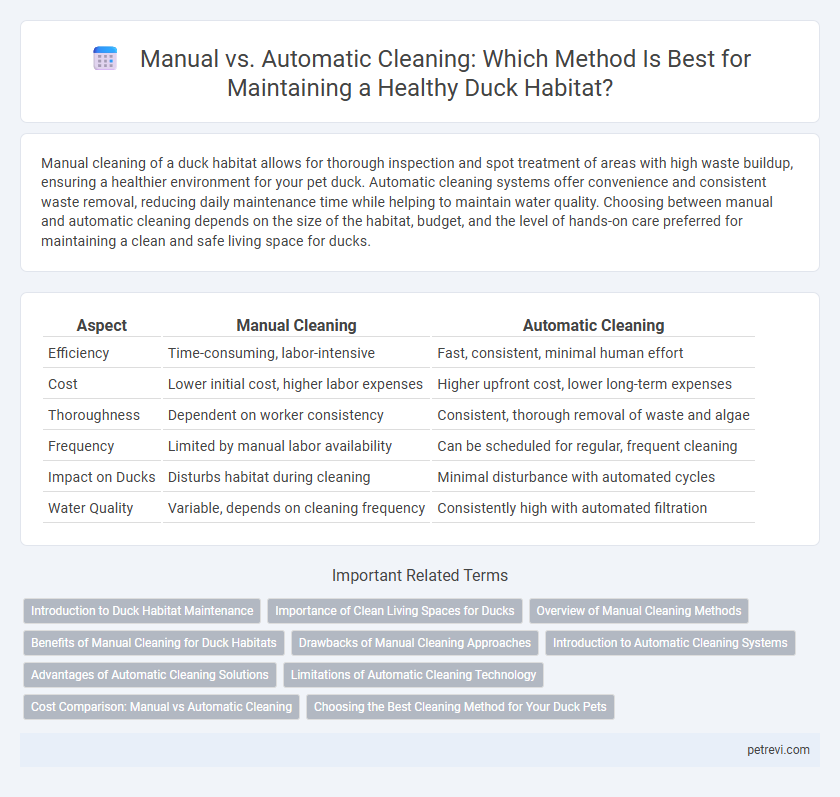Manual cleaning of a duck habitat allows for thorough inspection and spot treatment of areas with high waste buildup, ensuring a healthier environment for your pet duck. Automatic cleaning systems offer convenience and consistent waste removal, reducing daily maintenance time while helping to maintain water quality. Choosing between manual and automatic cleaning depends on the size of the habitat, budget, and the level of hands-on care preferred for maintaining a clean and safe living space for ducks.
Table of Comparison
| Aspect | Manual Cleaning | Automatic Cleaning |
|---|---|---|
| Efficiency | Time-consuming, labor-intensive | Fast, consistent, minimal human effort |
| Cost | Lower initial cost, higher labor expenses | Higher upfront cost, lower long-term expenses |
| Thoroughness | Dependent on worker consistency | Consistent, thorough removal of waste and algae |
| Frequency | Limited by manual labor availability | Can be scheduled for regular, frequent cleaning |
| Impact on Ducks | Disturbs habitat during cleaning | Minimal disturbance with automated cycles |
| Water Quality | Variable, depends on cleaning frequency | Consistently high with automated filtration |
Introduction to Duck Habitat Maintenance
Effective duck habitat maintenance requires balancing manual cleaning and automatic cleaning techniques to ensure a healthy environment. Manual cleaning allows for targeted debris removal and inspection of water quality, while automatic cleaning systems offer consistent waste management and reduce human labor. Combining both methods optimizes habitat conditions, promoting duck health and biodiversity.
Importance of Clean Living Spaces for Ducks
Maintaining clean living spaces in duck habitats is crucial for preventing the spread of diseases and ensuring optimal health. Manual cleaning allows for detailed spot treatments of contaminated areas, while automatic cleaning systems offer consistent sanitation with reduced labor. Prioritizing regular cleaning methods supports better air quality, reduces harmful bacteria, and promotes natural duck behaviors essential for their well-being.
Overview of Manual Cleaning Methods
Manual cleaning methods for duck habitat maintenance involve hands-on tasks such as removing debris, scrubbing surfaces, and changing water regularly to ensure a healthy environment. These processes often require tools like brushes, nets, and buckets to physically extract dirt, algae, and waste that can accumulate in ponds or enclosures. Despite being labor-intensive, manual cleaning allows for detailed inspection and targeted removal of contaminants, promoting optimal water quality and duck health.
Benefits of Manual Cleaning for Duck Habitats
Manual cleaning of duck habitats allows for precise removal of debris and contaminants, ensuring a healthier environment tailored to the specific needs of the ducks. It enables early detection of potential issues such as mold, algae, or harmful bacteria, reducing the risk of disease outbreaks. The hands-on approach also provides opportunities for habitat enrichment and careful monitoring of duck behavior and health.
Drawbacks of Manual Cleaning Approaches
Manual cleaning of duck habitats often leads to inconsistent sanitation due to human error and limited reach, which can increase the risk of disease transmission among waterfowl. The labor-intensive process requires significant time and effort, making it less efficient for large-scale or frequent maintenance compared to automated systems. Furthermore, manual methods may disturb the ducks, causing stress and potential disruption to their natural behaviors and habitat.
Introduction to Automatic Cleaning Systems
Automatic cleaning systems for duck habitats utilize advanced technology such as sensors, timers, and water filtration to maintain optimal cleanliness with minimal human intervention. These systems reduce the buildup of waste, control water quality, and improve air circulation, promoting healthier living conditions for ducks. Implementation of automatic cleaning enhances efficiency, lowers labor costs, and ensures consistent habitat hygiene.
Advantages of Automatic Cleaning Solutions
Automatic cleaning solutions for duck habitats significantly enhance hygiene by continuously removing waste and reducing harmful bacteria buildup, promoting healthier living conditions. These systems minimize labor costs and time, allowing for consistent maintenance without human error or fatigue. Automated methods also ensure water quality is maintained by filtering and circulating water efficiently, supporting the well-being and growth of ducks.
Limitations of Automatic Cleaning Technology
Automatic cleaning technology for duck habitats often struggles to accommodate the diverse environmental needs of ducks, such as varying water depths and natural debris removal. These systems may fail to effectively address organic waste accumulation, leading to inadequate sanitation and potential health risks for the ducks. Manual cleaning remains essential for targeted maintenance tasks requiring human judgment and flexibility in maintaining optimal habitat conditions.
Cost Comparison: Manual vs Automatic Cleaning
Manual cleaning of duck habitats generally incurs higher labor costs due to the intensive time and effort required for thorough sanitation. Automatic cleaning systems, while involving a significant initial investment, offer long-term savings by reducing labor expenses and improving cleaning efficiency. Over time, automated solutions often prove more cost-effective for maintaining large-scale duck habitats with consistent hygiene standards.
Choosing the Best Cleaning Method for Your Duck Pets
Manual cleaning of duck habitats allows for precise removal of debris and targeted sanitation, ensuring optimal health conditions for pet ducks. Automatic cleaning systems offer consistent maintenance, reducing labor while maintaining water quality and minimizing harmful bacteria growth. Selecting the best cleaning method depends on habitat size, duck population, and owner preferences for time investment and hygiene control.
Manual Cleaning vs Automatic Cleaning for Duck Habitat Maintenance Infographic

 petrevi.com
petrevi.com